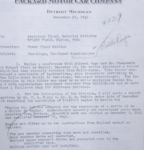Deleted member 68059
Staff Sergeant
- 1,056
- Dec 28, 2015
As I understand the two companies simply took different ways of manufacturing an engine to the required tolerances.
In the UK, with cheaper labour and (generally) shorter production volumes they'd produce components to looser tolerances, then after manufacture get these groups into matching assemblies with the required tolerance.
In the US, with more expensive labour, larger production runs and presumably a more highly developed capital raising system they'd spend more on production machinery that produced tighter tolerances in the first place, without requiring the manual sorting and matching.
Both were valid for their particular circumstances.
I`d been waiting for someone to lay down all the Ford, RR and Packard drawings next to eachother and check the tolerances. Seems like you must have done that yourself, Please reply with drawing #`s and tolerances.
All the first 2-stage packards were made with conversion kits which Derby shipped to packard. What a miracle they all fitted right onto the Packard engines.
(NARA-6550737)
Attachments
Last edited:


